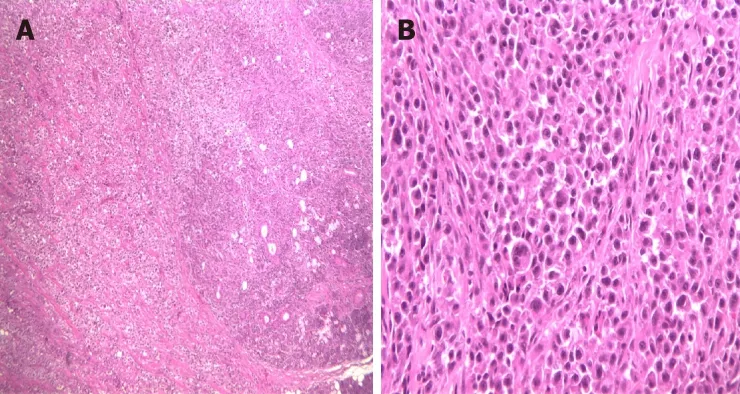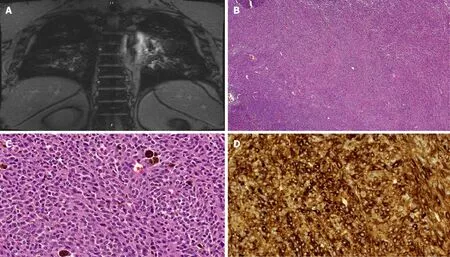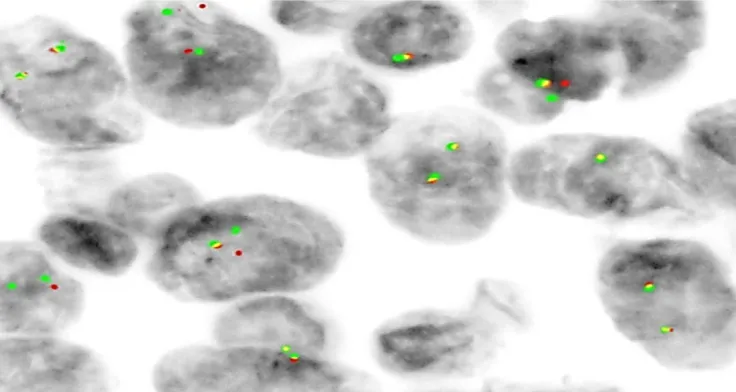Clear cell sarcoma in unusual sites mimicking metastatic melanoma
Ifeyinwa E Obiorah, Metin Ozdemirli
Ifeyinwa E Obiorah, Metin Ozdemirli, Department of Pathology, Medstar Georgetown University Hospital, Washington, DC 20007, United States
Abstract
Key words: Clear cell sarcoma; Melanoma; Salivary gland; Spine; Fluorescence in situ hybridization; Case report
INTRODUCTION
Clear cell sarcoma (also known as melanoma of the soft parts) was initially described by Dr. Franz Enzinger[1]in 1965, when he identified it as a sarcoma arising from the tendons and aponeurosis of extremities with a distinctive clinical and morphological pattern. Today, we understand clear cell sarcoma to be an aggressive tumor that accounts for only 1% of all soft tissue sarcomas, affecting mainly adolescents and young adults, and associated with local recurrences and late metastasis. Although both malignant melanoma and clear cell sarcoma display similar melanocytic markers, the two disorders are genetically distinct. Cases of malignant melanoma may contain BRAF mutations[2], whereas clear cell sarcoma lacks this mutation[3]and characteristically exhibits the reciprocal translocation t(12;22)(q13;q12) resulting in a rearrangement of the EWS RNA binding protein 1 (EWSR1) gene[4,5].
Li 2013a: Li Xuezhu (李学竹), Munimatālakāra の梵文写本について [Sanskrit manuscript of the Munimatālakāra], Mikkyō bunka 229.
Clear cell sarcoma of the head and neck are uncommon[6,7]. Tumors arising from the salivary glands are extremely rare but have been described previously in the parotid gland[8-10]. Similarly, clear cell sarcoma of the thoracic spine or paraspinal soft tissues is very rare and very few cases have been reported[11]. To our knowledge, no cases of clear cell sarcoma of the submandibular gland have been published in the literature.We report herein the clinicopathologic findings of two cases of primary clear cell sarcoma arising in the submandibular gland and the thoracic spine, respectively, and highlight the challenges in their diagnosis as well as the importance of molecular genetics in differentiating this tumor type from malignant melanoma.
CASE PRESENTATION
Case 1
Chief complaints:A 37-year-old female presented to our hospital with complaint of left jaw pain and swelling.
History of present illness: The patient reported the symptoms having been present for 6 mo.
History of past illness: The patient’s past medical history was unremarkable.
Physical examination:A left neck mass was felt on palpation.
Laboratory testing:Histological assessment of a fine-needle aspirate of the mass showed epithelioid-looking neoplastic cells with enlarged eccentric nuclei and prominent nucleoli. Based on these cytomorphologic features, the differential diagnosis of a high-grade carcinoma, hyalinizing clear cell carcinoma, and malignant melanoma was proposed.
Surgical investigation and resection:The patient was referred to the surgical team and based on the preliminary diagnosis, it was decided that the mass should be resected along with regional lymph node dissection. The patient underwent a left neck dissection and excision of the left neck mass. Histopathologic examination revealed nests of poorly differentiated malignant cells with pleomorphic vesicular nuclei, mitotic figures and clear cytoplasm (Figure 1). The tumor cells had invaded the adjacent soft tissue but no bone involvement was present. The cervical lymph node dissection yielded two metastatic adenopathies among the eighteen dissected lymph nodes. Immunohistochemical staining showed that the neoplastic cells were positivefor Human Melanoma Black-45 (commonly known as HMB-45; a melanocytic tumor marker) (Figure 2A), S-100 (Figure 2B) and vimentin, but were negative for cytokeratin (Figure 2C), calponin, smooth muscle actin, synaptophysin,chromogranin, and glial fibrillary acidic protein. Some of the tumor cells contained melanin pigment, which reacted positively in Masson Fontana staining (Figure 2D).These results supported the initial diagnosis of malignant melanoma and excluded the diagnosis of a clear cell carcinoma due to negativity for cytokeratin.
Case 2
Chief complaints: A 33-year-old male presented to our institution with complaint of mid back pain radiating to the flanks, and leg weakness and numbness, with gait abnormalities.
History of present illness:The patient reported the symptoms having been present for 6 mo.
History of past illness: The patient had no past medical history.
Physical examination: On physical examination, the patient showed a wide-based,unsteady gait, with weakness and decreased sensation and reflexes in both lower limbs.
Imaging examination:An MRI scan showed a mass enhancement in the T6 and T7 region of the spine (Figure 3A), raising suspicion of a paraspinal mass causing compression on the spinal cord.
Surgical investigation and resection:The patient was referred to the neurosurgical team, who decided to completely resect the tumor for pathological assessment to determine the diagnosis. A T6-7 laminectomy was performed, with complete resection of the tumor. Intraoperatively, the tumor was found to grossly involve the thoracic spine, with predominant involvement of the paraspinal soft tissues. Pathological examination of the resected neoplasm showed fascicles and nests of spindle cells(Figure 3B) with epithelioid features, eosinophilic cytoplasm, occasional mitosis, and pigment in some of the cells (Figure 3C). The tumor cells were positive for HMB-45(Figure 3D), S-100 and melanoma antigen (Melan-A), but were negative for cytokeratin, desmin, smooth muscle actin, and glial fibrillary acidic protein. The pigment in the tumor cells was confirmed to contain melanin by reacting positivity with the Masson Fontana stain. These results supported the initial diagnosis of malignant melanoma.
MULTIDISCIPLINARY EXPERT CONSULTATION
Case 1
The case was sent out to two different institutions, with all subsequent experts agreeing with the diagnosis of melanoma. An extensive dermatological,ophthalmological and radiological workup of the patient was performed to rule out a primary site. Skin and mucosal surfaces did not reveal any suspicious lesions. A whole-body positron emission tomography/computed tomography scan and magnetic resonance imaging (MRI) of the head and neck region did not show any ocular involvement or masses in any other sites.
Case 2
This case was handled fully within our institution by the clinical staffs described.
FINAL DIAGNOSIS
Case 1
At this time, the diagnosis was melanoma.
Case 2
Because our past experience had taught us that clear cell sarcoma can readily mimic malignant melanoma, a FISH study was ordered. An EWSR1 gene rearrangement on chromosome 22q12 was found (Figure 4). This confirmed the diagnosis of clear cell sarcoma of the thoracic spine involving the paraspinal soft tissues.

Figure 1 Histopathology of the submandibular gland mass in Case 1. A: Section of the mass showed nests of poorly differentiated tumor cells infiltrating into the benign acinic cells (HE,× 50); B: Neoplastic cells displayed pleomorphic, bizarre nuclei with prominent nucleoli and mitotic figures (HE,× 400). HE: Hematoxylin and eosin.
TREATMENT
Case 1
The patient was started on adjuvant therapy with interferon alpha-2 (18 MIU three times a week for 8 wk). Two months later, the patient developed an enlarged left supraclavicular lymph node. She was started on localized radiation (4 fractions of 8 Gy weekly) to the supraclavicular node, in addition to the interferon 2-alpha she was currently on. While on treatment, the tumor progressed to involve the left pterygoid region, extending towards the inferior aspect of the left masseter muscle and the temporalis muscle. The patient underwent an extensive resection of the tumor with partial removal of her left jaw, followed by additional radiation therapy.
OUTCOME AND FOLLOW-UP
Case 1
Four months later, the patient presented with metastatic disease to the lungs, spine and left neck soft tissue, and died shortly afterward. On further review at 8 years later, we sent the resected tumor specimen for retrospective florescence in situ hybridization (FISH). A rearrangement of the EWSR1 gene on chromosome 22q12 was found, confirming the diagnosis of clear cell sarcoma.
Case 2
Following surgery, a repeat MRI showed no evidence of residual tumor. Apart from lower back pain which was managed with pain medications, the post-operative course was uncomplicated. The patient was able to slowly ambulate with mild muscle weakness. The patient was discharged and referred to physical therapy for rehabilitation. Two months post-surgery, the patient was stable, ambulatory and undergoing physical therapy with no recurrence of the thoracic tumor on MRI.Adjuvant standard fractionation radiotherapy (2 Gy a day) was given for 5 d. At 6 mo post-surgery follow-up visit, MRI showed post-surgical changes in the mid thoracic region with no evidence of a recurrent tumor. Currently the patient has intermittent lower back pain due to poor posture and has no neurological deficits. His muscle strength has greatly improved due to compliance with physical therapy. The patient will be monitored closely for recurrence with MRI every 6 mo.
DISCUSSION
Clear cell sarcoma typically involves tendons and aponeurosis[1,12]of adolescents and young adults of both sexes. The tumor usually presents as a small insidiously growing mass, but it can suddenly become aggressive and rapidly metastasize, as was observed in our patient (Case 1). Following Enzinger’s initial description of the clear cell sarcoma, Chung and Enzinger[12]demonstrated melanin in 72% of tumors with clear cell sarcoma, supporting their origin from migrated neural crest cells. As such,they coined the name “malignant melanoma of soft parts”, which seems preferable over the more descriptive term of clear cell sarcoma. In addition, clear cell sarcomahas been shown to be positive for antigens associated with the synthesis of melanin,such as HMB-45, S-100 protein and Melan-A[13,14]. Moreover, electron microscopy has demonstrated melanosomes in clear cell sarcoma, similar to malignant melanoma. For these reasons, clear cell sarcoma is thought to be a subtype of malignant melanoma,albeit genetically distinct. Typically, cases of clear cell sarcoma have a reciprocal translocation [t(12;22)(q13;q12)] resulting in an EWSR1-activating transcription factor(ATF) gene fusion[4,5,15]. The second major differential diagnosis of clear cell sarcoma will include a clear cell carcinoma, such as the hyalinizing clear cell carcinoma;however, carcinomas are readily diagnosed by immunohistochemistry, which should show a positive cytokeratin stain.
Herein, we present first a case of clear cell sarcoma occurring in the submandibular gland (Table 1) that closely resembled a malignant melanoma on histological analysis.There was a concurrence of the initial malignant melanoma diagnosis when two outside institutions were consulted. The initial misdiagnosis was due to the morphologic and immunohistochemical similarities between clear cell sarcoma and malignant melanoma and lack of awareness of the t(12;22)(q13;q12) translocation,which was only recently described. Immunohistochemistry excluded a clear cell carcinoma, smooth muscle tumors, neuroendocrine neoplasms, or primary brain tumors. Additional supportive findings for the case to be a primary clear cell sarcoma are that the lesion was solitary and metastasis was present only in the cervical lymph nodes draining from the submandibular mass. These findings illustrate the typical spread of clear cell sarcoma from a primary site to regional lymph nodes[12,14].Secondly, there was absence of malignancy elsewhere in the body, thereby supporting our diagnosis of a primary clear cell sarcoma arising from the submandibular gland.To our knowledge, this is the first report to describe a case of primary clear cell sarcoma of the submandibular gland. In general, clear cell sarcoma of the salivary gland is extremely rare. At the time of this report only three cases involving the salivary gland have been published, all of which had arisen in the parotid gland and were treated surgically[8,10]. Only one of those cases[10]recurred after surgery, and the patient was alive with no evidence of the disease after radical neck surgery and adjuvant radiotherapy.
Our second case presented with a T6-7 paraspinal mass, which was given an initial diagnosis of malignant melanoma. Based on our previous experience we performed FISH testing, which demonstrated the EWRS1 rearrangement and confirmed the diagnosis of clear cell sarcoma. Clear cell sarcoma of the thoracic spine or paraspinal soft tissues is extremely rare. Gao et al[11]found only four cases reported in the literature. All of these presented with back pain. Two of these patients were treatedsuccessfully by complete resection of the tumor with clear margins, while another patient was treated with surgery and chemotherapy, and experienced local recurrence[16]. There was no follow-up information for the fourth case[17]. Surgery is the mainstay of treatment for clear cell sarcoma, with chemotherapy having little effect[18,19]. About a third of patients with clear cell sarcoma receive radiotherapy mostly in conjunction with surgery. Although radiation therapy has been shown to reduce the size of these tumors, clear beneficial effects of radiotherapy alone is difficult to assess since most cases are given either pre- or post-operatively[18,19].Chemotherapy is predominantly used in patients with metastatic disease, however,prognosis is very poor, with an estimated 5-year survival rate of only 15%[18,20].Targeted therapies, such as receptor tyrosine kinase inhibitors and histone deacetylase inhibitors, have shown benefit in some patients with this high-grade sarcoma, but most of these treatment strategies have so far only been applied in clinical trial settings[21]. Although surgery remains the treatment of choice for clear cell sarcoma,these tumors tend to recur. The reported rates of local recurrence of clear cell sarcoma following surgery reach up to 84%, with late metastases up to 63% and metastases at presentation up to 30%[5,14]. A recent review by Gonzaga et al[22]showed that the approximate 5- and 10-year overall survival for 489 patients with clear cell sarcoma was 50% and 38%, respectively. The estimated 5-year survival for Stages I-IV was 75%, 65%, 35% and 15%, respectively. In addition, the mean survival for Stage I was 94.9 mo, Stage II was 94.7 mo, Stage III was a median of 24.9 mo, and Stage IV was a median of 8.9 mo. Our first patient (case1) underwent complete excision of the tumor but the patient had metastasis to the regional lymph nodes. It is possible that the metastatic lymph nodes were not completely excised which led to recurrence.Although the diagnosis of the patient was not evident at the time, the patient received the correct modalities of therapy published in the literature which included surgery and radiotherapy. However, the aggressiveness and rapid progression of the disease led to fatal consequences. The second patient had complete surgical resection with adjuvant radiation treatment. The patient is currently stable with an estimated 5-year survival of about 70% based on prior studies[22]. We recently reported a case of clear cell sarcoma of the dermis that was completely excised and the patient is currently disease free two years post resection[23]. Based on our limited experience and published literature, it appears that early detection and tumor resection is the key to good clinical outcome[22,23]. Due to the rarity of the entity in the submandibular gland and thoracic spine, it is not possible at present to predict the outcome of treatment in the afflicted patients.

Figure 3 Radiology and pathology of the thoracic paraspinal mass in Case 2. A: Magnetic resonance imaging of the tumor showed an enhancing thoracic spine mass involving the paraspinal soft tissues; B: Sections of the mass showed fascicles and nests of spindle cells (HE, × 50); C, D: Neoplastic cells displayed melanin pigments (HE, × 400) and positivity for Human Melanoma Black-45 by immunohistochemistry (× 400). HE: Hematoxylin and eosin.

Figure 4 Fluorescence in situ hybridization analysis of the spinal tumor in Case 2. Fluorescence in situ hybridization using a dual-color, break-apart probe for EWSR1 demonstrated one normal fusion (yellow) along with an extra red signal and extra green signal, indicating translocation.
CONCLUSION
Clear cell sarcoma of the submandibular gland and thoracic spine or paraspinal soft tissues are rare disease entities. The presentation, histology, and tumor prognosis appear to be similar to the clear cell sarcoma arising elsewhere. FISH studies should be done on all tumors that demonstrate melanocytic markers without a cutaneous or mucosal malignant melanoma, to prevent a misdiagnosis of malignant melanoma.Although malignant melanoma and clear cell sarcoma are both aggressive tumors, it is important to differentiate between the two because of their different underlying pathophysiological pathways and therapeutic implications.

Table 1 Timeline of patient history and medical intervention of case 1

